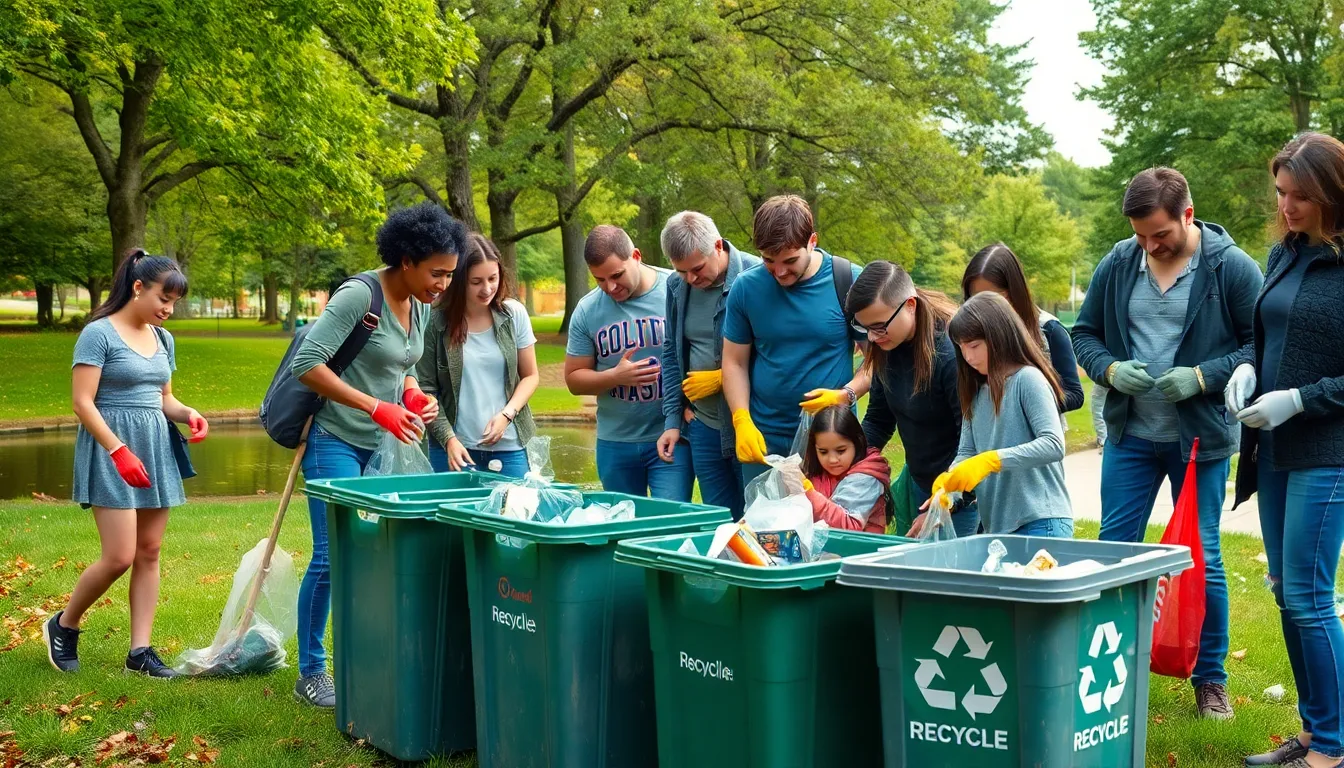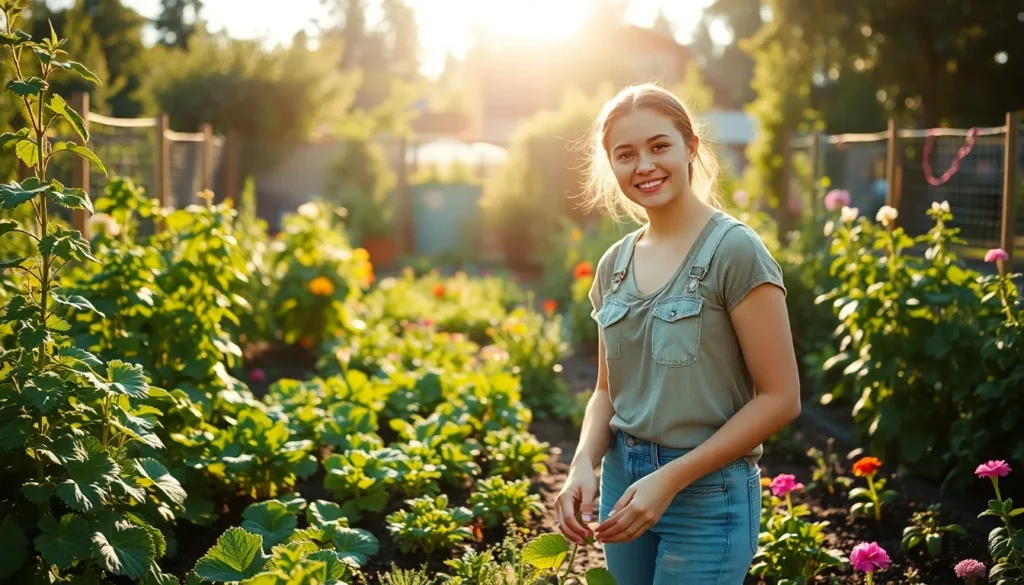Sustainable living isn’t just a trendy buzzword tossed around at eco-friendly brunches. It’s a lifestyle choice that could save the planet while saving you a few bucks—who doesn’t love a little extra cash in their pocket? Imagine reducing waste, conserving resources, and living in harmony with nature, all while feeling like a superhero in your own home.
Table of Contents
ToggleUnderstanding Sustainable Living Meaning
Sustainable living refers to practices that reduce an individual’s or community’s environmental impact. It’s about using resources efficiently to meet present needs without compromising future generations’ ability. This lifestyle encourages minimal waste and promotes renewable resources.
Emphasizing ecological balance, sustainable living cultivates a connection to nature. Individuals practicing this lifestyle often engage in recycling, composting, and using public transportation. Conservation of energy and water emerges as another critical aspect. Moreover, organic products typically come into play, offering healthier choices for both consumers and the environment.
An example of sustainable living involves choosing locally sourced foods. This choice not only supports local economies but often reduces greenhouse gas emissions tied to transporting food over long distances. Engaging in community gardens serves as another practical method, allowing individuals to grow fresh produce while fostering community spirit.
Reducing single-use plastics constitutes a significant behavior change associated with sustainable living. Many individuals opt for reusable bags, containers, and utensils to limit plastic waste. Such choices resonate far beyond individual actions, contributing to global efforts against plastic pollution.
Often, sustainable living integrates awareness about ethical consumerism. Individuals consider the environmental footprint of products and services, favoring those that practice fair trade and environmentally friendly production methods. This shift leads to wider demand for sustainable products, influencing markets toward greener options.
Living sustainably means understanding the interconnectedness of choices, behaviors, and their impacts. Individuals find themselves embracing practices that promote health, environmental integrity, and economic responsibility. Choices made today matter for the sustainability of tomorrow’s world.
Key Principles of Sustainable Living

Sustainable living revolves around key principles that enhance environmental, social, and economic well-being. Understanding these principles fosters a deeper commitment to sustainability in daily life.
Environmental Responsibility
Environmental responsibility encompasses actions aimed at minimizing ecological footprints. Individuals can reduce waste through practices such as recycling and composting, which divert materials from landfills. Conserving energy and water also plays a critical role; simple adjustments like using energy-efficient appliances and fixing leaks make a significant impact. Additionally, choosing public transportation helps decrease greenhouse gas emissions. Engaging with local ecosystems by participating in community clean-up efforts promotes biodiversity and supports environmental health.
Social Equity
Social equity ensures that all individuals have access to resources and opportunities. Prioritizing fair trade products encourages ethical consumption, benefiting producers and communities. Supporting local businesses strengthens economies and fosters authentic relationships within communities. Active participation in social initiatives enhances community cohesion and inclusivity. Striving for social equity includes advocating for marginalized groups, ensuring everyone participates in discussions about sustainability. Informed choices enhance quality of life, close the gap between different demographics, and empower communities collectively.
Economic Viability
Economic viability examines the financial aspects of sustainable practices. Choosing sustainable products often leads to long-term cost savings through reduced waste and energy efficiency. Investments in renewable energy, like solar panels, generate savings over time while increasing property value. Supporting local economies through purchasing local products stimulates job growth and strengthens communities. Moreover, developing sustainable business models encourages innovation and resilience, ensuring future economic security. Fiscal responsibility incorporates environmental considerations, aligning personal values with financial decisions for a healthier planet and prosperous economy.
Benefits of Embracing Sustainable Living
Embracing sustainable living yields numerous benefits that enhance both personal well-being and environmental health.
Improved Health and Well-being
Sustainable living promotes healthier lifestyles through the consumption of organic foods. Individuals often experience better physical health by choosing locally sourced produce. This choice reduces exposure to harmful chemicals found in processed foods. Additionally, engaging in outdoor activities strengthens connections with nature, fostering mental clarity and emotional stability. Studies link time spent in green spaces to lower stress levels. Active transportation methods, such as biking or walking, encourage physical fitness while minimizing carbon footprints.
Conservation of Resources
Conserving resources plays a crucial role in sustainable living. By reducing energy consumption, individuals lower utility bills while decreasing greenhouse gas emissions. Strategies, such as using energy-efficient appliances and implementing water-saving techniques, enhance resource conservation. Practicing minimalism further reduces waste and encourages thoughtful consumption. Many people find that reducing reliance on single-use materials not only protects the environment but also fosters creativity in using alternative resources. Sustainable practices contribute to preserving ecosystems and ensuring future generations have access to vital resources.
Practices for Sustainable Living
Sustainable living involves practical actions that individuals and communities can adopt. Prioritizing eco-friendly choices makes a significant impact on the environment.
Energy Efficiency
Energy-efficient practices reduce overall consumption and environmental impact. Using LED light bulbs consumes up to 75% less energy than traditional incandescent bulbs. Investing in Energy Star appliances further minimizes energy use, leading to lower utility costs. Homeowners can enhance insulation to prevent heat loss, which improves both comfort and energy savings. Additionally, utilizing smart thermostats optimizes heating and cooling schedules, resulting in further reductions in energy consumption.
Waste Reduction
Waste reduction practices play a vital role in minimizing environmental footprints. Composting organic waste can divert up to 30% of household waste from landfills. Choosing reusable bags, containers, and bottles limits reliance on single-use plastics. Participating in local recycling programs ensures materials like paper, glass, and metals are reused effectively. Engaging in a minimalist lifestyle encourages thoughtful consumption, reducing excess and waste. Community initiatives, like swap events or repair cafes, promote sharing and extend the life cycle of items, further supporting waste reduction efforts.
Challenges in Achieving Sustainable Living
Sustainable living faces several challenges that hinder widespread adoption.
Awareness and Education
Awareness surrounding sustainable practices often lacks depth. Many individuals don’t understand the full scope of their environmental impact. Education plays a critical role in changing this narrative. Community programs and workshops can offer insights into sustainable choices, from waste reduction to energy efficiency. Schools that incorporate sustainability into their curricula help foster a new generation of environmentally conscious citizens. Research shows that informed individuals are more likely to adopt responsible habits. Engaging local organizations to spread awareness can cultivate a culture of sustainability.
Economic Barriers
Economic barriers significantly influence the transition to sustainable living. Individuals and families may find sustainable products more expensive than conventional alternatives. Price differences often deter consumers from choosing eco-friendly options. In some cases, financial incentives or government subsidies can alleviate these costs. Local businesses adopting sustainable practices may face initial expenses that impact pricing. When communities support local green initiatives, this builds a more equitable marketplace. Long-term savings from energy efficiency or waste reduction can offset upfront investments. As awareness increases, demand for affordable sustainable solutions is likely to grow.
Embracing sustainable living is a transformative journey that fosters a deeper connection with the environment. By adopting practices that prioritize resource conservation and waste reduction, individuals can significantly reduce their ecological footprint. This lifestyle not only benefits the planet but also enhances personal well-being through healthier choices and community engagement.
As awareness of sustainability grows, it becomes increasingly vital to support initiatives that promote ethical consumerism and social equity. The collective effort to live sustainably can lead to lasting change, ensuring future generations inherit a healthier planet. By making informed choices today, everyone can contribute to a more sustainable and equitable world.






